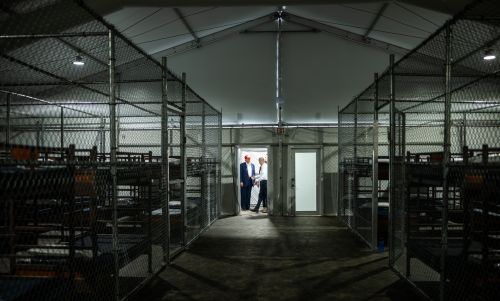

The closure of Alligator Alcatraz should have marked the end of a controversial chapter in U.S. immigration detention. Instead, it opened a darker one.

By Matthew A. McIntosh
Public Historian
Brewminate
Immigrant Disappearances, State Secrecy, and Historical Parallels
Lawyers and families searching for loved ones detained at the notorious “Alligator Alcatraz” facility in Florida are now left with silence and empty records. After the detention center’s closure, lawyers and advocates discovered that hundreds of immigrants had simply vanished from ICE’s online database, with no transfer logs, deportation notices, or explanations. Attorneys describe it as a “black hole” where detainees disappear without a trace, leaving families desperate for answers.
The scope of the crisis is staggering. A Miami Herald investigation reported that nearly two-thirds of the people held at Alligator Alcatraz in July could not be accounted for just weeks later. Officials insist that many were deported or relocated, but without public documentation, there is no way to confirm who left, where they went, or if they are even alive. The opacity has sparked comparisons to some of history’s darkest practices, disappearances under Nazi Germany and the desaparecidos of Latin America, where governments concealed the fates of those taken into custody.
What We Know: The Case of Alligator Alcatraz
“Alligator Alcatraz” was built in the Florida Everglades as a high-security immigration detention facility, quickly earning a reputation for harsh conditions and secrecy. When officials announced its closure, they claimed detainees were being processed and moved elsewhere. Yet soon after, attorneys discovered that hundreds of detainees had effectively disappeared from ICE’s records. As El País reported, families calling ICE hotlines were told their relatives no longer appeared in the system, and lawyers could not locate clients who had previously been confirmed in custody.
The alarm grew louder when immigration attorneys documented a sudden “data blackout” in ICE’s detention database. According to the Latin Times, detainees simply vanished from official logs without any record of transfer or deportation. Lawyers described the database as a “black hole,” where people fell out of the system with no paper trail to follow.
Investigations by local journalists have underscored the scale of the disappearances. The Miami Herald report revealed that in July alone, nearly two-thirds of the people detained at Alligator Alcatraz could not be located by the end of the month. Some state officials, including Florida’s governor, insisted that detainees had been deported or removed from the state. But without transparent documentation, those claims remain unverifiable. The result is a widening crisis of accountability, where families and advocates cannot even confirm the basic whereabouts of the people once held behind the facility’s walls.
The Framework of Enforced Disappearances
What is happening in Florida bears disturbing similarities to what international law defines as enforced disappearance: when a state detains or abducts individuals, refuses to acknowledge their fate, and places them outside the protection of the law. The United Nations has repeatedly declared enforced disappearance a crime under international law, citing its use by authoritarian regimes to silence dissent and erase populations without accountability.
History offers chilling precedents. In Nazi Germany, individuals targeted by the regime were taken into custody and sent to concentration camps without records or communication to their families. The disappearance itself was a tool of terror, spreading fear through uncertainty. Families never knew if loved ones were alive or dead until it was too late.
Latin America provides another stark example. During Argentina’s “Dirty War” of the 1970s and 1980s, tens of thousands of people were abducted and became known as the desaparecidos. The government denied knowledge of their whereabouts while carrying out extrajudicial killings and secret detentions. Similar tactics were used in Chile, Guatemala, and elsewhere, where enforced disappearances became a defining weapon of authoritarian control (Amnesty International).
The comparison does not suggest identical outcomes, but the structural resemblance is hard to ignore: people taken by the state, records vanishing, families left in the dark, and official denials filling the vacuum. The lesson from history is that when detainees vanish into bureaucratic silence, the system shifts from immigration enforcement to something far more dangerous.
The Stakes and Consequences
For the families of the disappeared, the immediate consequence is anguish. Loved ones are suddenly untraceable, with no confirmation of transfer, deportation, or even survival. Attorneys working on behalf of detainees describe being unable to contact clients, leaving ongoing asylum cases in limbo. As El País documented, mothers call detention hotlines daily only to be told their sons “are not in the system,” a phrase chillingly familiar to those who study authoritarian repression.
The legal stakes are equally severe. Without records, immigrants are effectively denied due process, stripped of their right to counsel, and cut off from the protections of habeas corpus. The Miami Herald investigation noted that many of those unaccounted for had pending cases, meaning their disappearances function not only as physical erasure but also as legal nullification. This undermines the rule of law itself, substituting secrecy for transparency.
Democratically, the consequences ripple outward. When governments can make people vanish without accountability, they establish a precedent that can extend beyond immigration. The normalization of “black hole” detention systems, where individuals disappear without record, creates a model that could be applied to protesters, political opponents, or anyone deemed inconvenient. As history shows, once a government embraces disappearance as a tool, its use rarely remains confined to one population.
Possible Mechanisms and Actors
How could hundreds of detainees vanish without a trace from a federally operated detention system? Advocates point to several possible mechanisms. The most likely is undocumented transfers. ICE routinely moves detainees between facilities, but these movements are supposed to be logged in the agency’s database. When names vanish without transfer records, it suggests either deliberate data suppression or systemic failures in record-keeping.
Another possibility is mass deportations carried out without public notice. Florida officials have suggested that large numbers of Alligator Alcatraz detainees were deported, but offered no transparent documentation to confirm who left and when. The governor himself acknowledged “hundreds” of removals, but declined to provide details. Without verifiable records, the state’s claims do little to reassure families or attorneys who have lost all contact with detainees.
Private contractors may also play a role. Much of the U.S. immigration detention system relies on for-profit prison companies, subcontractors, and loosely regulated operators. If detainees were transferred into privately run sites, or even offshore facilities, without public oversight, the paper trail could vanish. This outsourcing creates layers of opacity that shield the federal government from direct accountability, making it nearly impossible to track where detainees are being held.
Finally, critics raise the possibility of intentional data manipulation. Immigration databases are vast and complex, but they are also easily subject to political pressure. A sudden “black hole” in the system, where hundreds of names vanish simultaneously, may reflect not clerical error but deliberate erasure. The absence of records serves a political function: if no one can be traced, then no one can challenge the government in court.
Investigative Routes and Evidence Needs
If the government will not provide answers, investigators must pursue them by other means. Immigration attorneys and watchdog groups are already filing Freedom of Information Act (FOIA) requests to obtain transfer logs, deportation records, and internal communications from ICE and the Department of Homeland Security. Such documents could reveal whether detainees were moved to other facilities, deported, or simply deleted from databases. Legal advocates stress that every detainee has a paper trail somewhere; the challenge is forcing the government to make it public.
Interviews with families and released detainees are another crucial avenue. Some immigrants who were briefly held at Alligator Alcatraz before its closure have described chaotic transfers, with buses leaving at night and no information about destinations. Gathering these testimonies could piece together patterns of movement, especially if corroborated by transport contracts or flight records. Past investigations into secret deportations have successfully traced detainee movements through airline manifests and contractor payment logs.
Technology also offers new tools. Satellite imagery could confirm whether detainees were relocated to other sites, especially if temporary holding facilities were erected in remote areas. Cross-referencing ICE data with court filings may expose inconsistencies, such as pending cases for individuals ICE claims were deported. Whistleblowers (whether detention staff, contractors, or ICE employees) could provide the missing pieces of the puzzle. As history shows in cases from Latin America to Guantánamo Bay, uncovering enforced disappearances often requires relentless pressure from journalists, lawyers, and human rights monitors working in tandem.
Institutional and Legal Remedies
The disappearances linked to Alligator Alcatraz demand urgent institutional accountability. Immigration attorneys have already begun filing habeas corpus petitions on behalf of missing detainees, forcing the government to disclose their whereabouts. Class-action lawsuits may follow, particularly if evidence emerges that ICE or contractors deliberately suppressed records. Courts could compel ICE to restore missing data, publish transfer logs, and provide access for families and legal counsel. These legal actions mirror past strategies used to challenge secret detentions at Guantánamo Bay, where litigation pried open layers of official silence.
Legislative oversight is another critical tool. Congress has the authority to subpoena records, call ICE and DHS officials for testimony, and mandate transparent detainee tracking systems. Lawmakers could also push for reforms similar to California’s No Secret Police Act, adapted to immigration enforcement, requiring visible identification for officers and public notification of transfers. Without binding rules, the risk of disappearances persists, fueled by bureaucratic opacity and political expediency.
Finally, international pressure may prove decisive. The United States is a signatory to human rights conventions that prohibit enforced disappearances, and organizations like the United Nations Working Group on Enforced or Involuntary Disappearances have intervened in similar cases worldwide. If domestic institutions fail to hold ICE accountable, international scrutiny could increase the cost of secrecy. Human rights monitors and NGOs can demand facility inspections, independent audits, and public disclosure of detainee rosters. History shows that secrecy thrives only when oversight fails; restoring accountability requires constant, visible checks on state power.
Risks, Objections and Counterarguments
Officials defending ICE’s handling of Alligator Alcatraz have offered familiar explanations: detainees were deported, transferred to other facilities, or released. Florida’s governor went so far as to claim that “hundreds” had been removed, portraying the disappearances as nothing more than bureaucratic backlog. ICE spokespeople have suggested that delays in updating databases explain why individuals cannot be located, framing the issue as clerical error rather than systemic abuse.
Yet these defenses falter under scrutiny. Deportations and transfers are supposed to be logged, with detainees’ legal representatives notified of changes. The sudden erasure of hundreds of names from the database suggests more than sloppy paperwork; it suggests intentional opacity. Lawyers describe the system as a “black hole,” where data doesn’t lag but simply vanishes. That kind of disappearance cannot be explained by bureaucratic delay alone.
Others argue that increased transparency might compromise security, exposing facility locations or detainee movements to potential threats. But this objection inverts the principle of democratic governance. The risk of secrecy far outweighs the risk of disclosure. As Amnesty International has noted, enforced disappearances thrive in environments where states invoke “security” to justify secrecy. In reality, transparency is itself a safeguard, ensuring that legitimate operations are distinguished from abuses. Without it, governments create conditions ripe for exploitation, impersonation, and authoritarian drift.
Conclusion and Call to Action
The closure of Alligator Alcatraz should have marked the end of a controversial chapter in U.S. immigration detention. Instead, it opened a darker one, hundreds of immigrants effectively vanishing into silence, their families left to search through hotlines and court filings for answers that never come. The parallels to history are too stark to ignore. From the desaparecidos of Latin America to the victims of Nazi Germany’s secret arrests, enforced disappearance has always been a hallmark of authoritarian regimes. The United States now faces a haunting question: is it repeating that pattern?
The consequences stretch far beyond the immigrants caught in this black hole. When a government can make people vanish without records, it erodes the foundations of law itself. Due process becomes meaningless, courts are sidelined, and families are left in limbo. Nearly two-thirds of those once detained in July could not be located. That silence is not a clerical error; it is a warning.
Democracies cannot survive in the shadows. The U.S. must confront this crisis with transparency, accountability, and urgency. Congress should demand full disclosure of detainee transfers, courts must enforce habeas protections, and international monitors must press for answers where domestic institutions falter. Above all, families deserve to know the truth. No society that calls itself free can accept the idea that people can simply disappear into the machinery of the state.
Originally published by Brewminate, 09.25.2025, under the terms of a Creative Commons Attribution-NonCommercial-NoDerivatives 4.0 International license.


